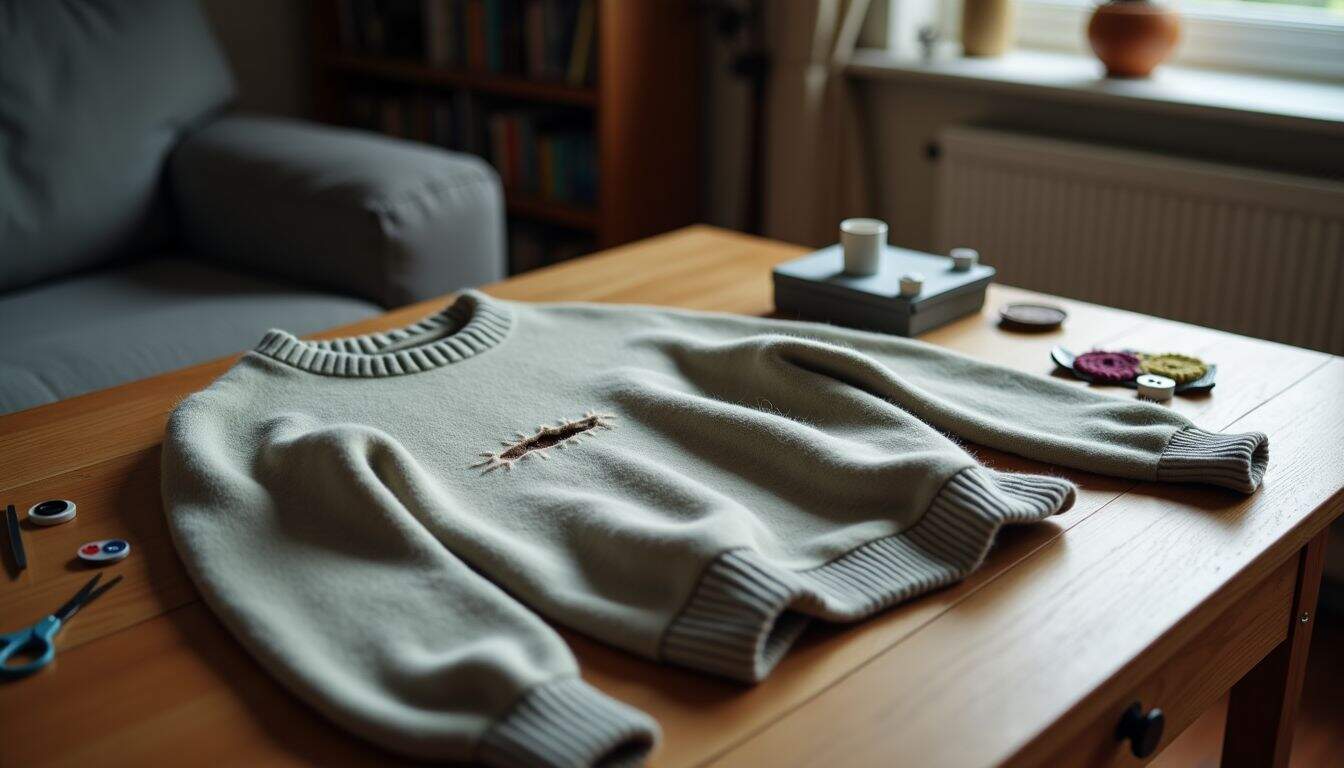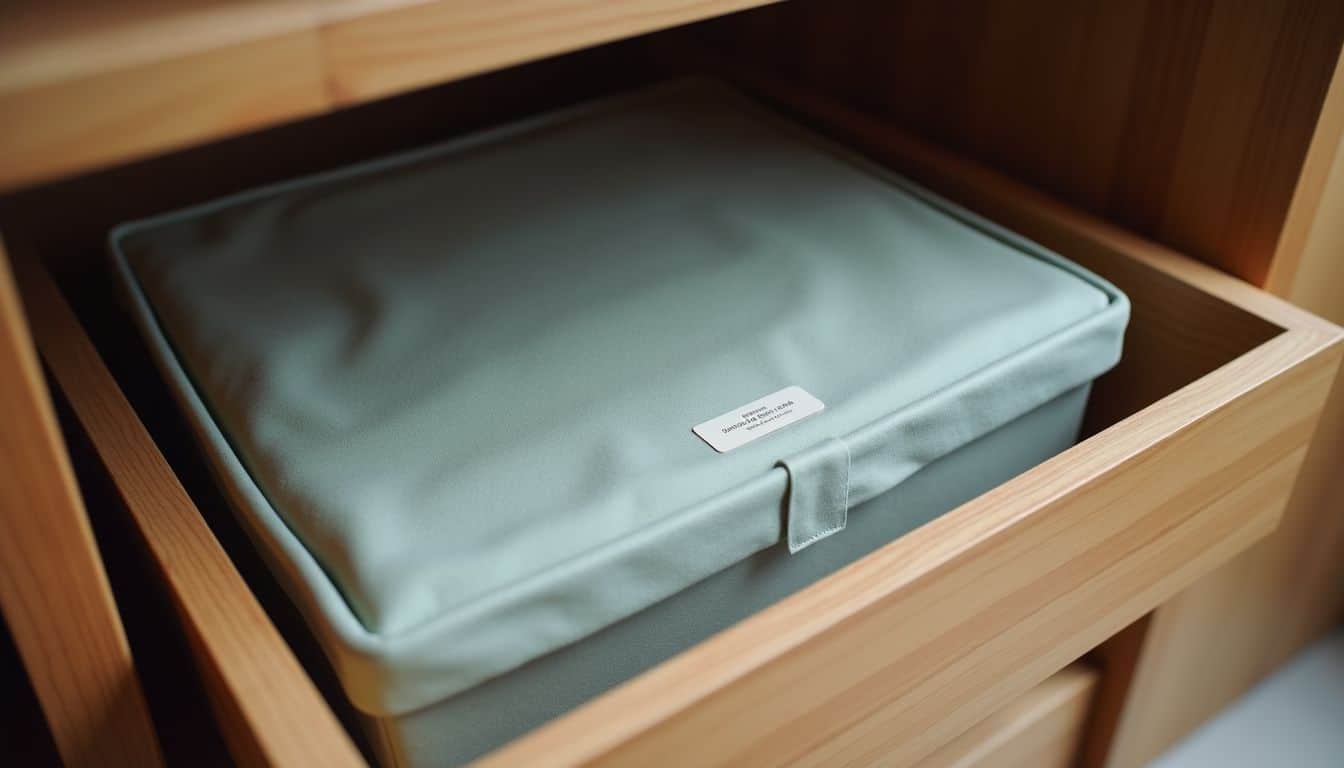Are you tired of pulling clothes out to find wrinkles, mildew, or worse—holes from pests? Knowing how to properly store clothes can save you money and keep your favorite attire looking fresh.
This guide gives easy tips on folding sweaters, using garment bags correctly, and even choosing the right storage containers. Keep reading for smart ways to protect your wardrobe!
Key Takeaways
Wash all clothes thoroughly, and dry them completely, before storing—to avoid mold, stains, and damage from lingering body oils.
Pick the ideal storage solution: sealed plastic containers keep moisture out, while fabric bags gently protect delicate clothing by letting air flow through.
Fold sweaters and heavier knitwear neatly; hangers stretch these garments out, causing them to lose shape.
Sort your stored clothes clearly by season and clothing type; it saves space, keeps things tidy, and helps you quickly grab exactly what you want.
Drop some silica gel packets into containers—they soak up extra moisture—and place cedar blocks nearby to gently ward off moths without unpleasant chemical odors.
Table of Contents
Prepare Clothes for Storage

Proper prep work saves your clothes from damage during storage. Clean items and fix small tears now to avoid bigger problems later.
Wash and dry all items

Clean clothes survive storage much better. Sweat, dirt, and body oils slowly weaken fabric fibers, so always wash everything before packing it away. I learned the importance of this, unfortunately, by ruining my favorite wool sweater—those stains refused to budge afterward! Be careful to follow the care label on each piece.
Some items need a professional dry cleaner, while others survive just fine in your home washing machine. Tumble drying generally works well, but air-drying is ideal for knitwear to maintain their shape.
Clothing must be fully dry before storage to avoid mold and mildew growth. Even a small bit of moisture trapped inside can cause permanent damage. I once tossed a slightly damp shirt into a plastic bin, then found ugly mold stains on it months later.
Let your laundry air out for at least a full day after washing—it guarantees complete dryness. This small detail makes a big difference in keeping fabrics in good shape. Before packing garments away, inspect each one carefully for damage needing repair.
If storage space at home runs tight, consider renting extra room through services like Flexible NSA Storage Rentals.
Repair any damage or tears

Broken buttons or even small tears quickly turn your favorite clothes into closet rejects. It helps to handle such problems right away, before putting items into storage. I once ignored a tiny rip in my wool sweater, and months later, discovered a hole large enough to poke fingers through—you don’t want to repeat that mistake.
A simple DIY fix takes just minutes; sew loose threads, reattach lost buttons, or patch minor holes. For trickier situations, take the garment to a local seamstress for professional repairs.
Either way, dealing promptly with damage will help extend your clothing’s lifespan.
Poorly fitting clothes often end up pushed far back in the closet and never worn. Instead of wasting valuable closet space, bring those clothes to a tailor for alterations. Pants that drag on the floor, shirts with overly loose sleeves, and jackets that slide awkwardly off shoulders—all these issues can easily be adjusted.
Once properly altered, your wardrobe will only hold clothing that fits well and suits you perfectly. Next up, find secure storage containers to protect your newly repaired outfits.
Choose the Right Storage Containers

The right storage boxes make a huge impact on keeping your clothes fresh and ready to wear. Plastic bins block out dust and bugs, while fabric bags let your clothes breathe during long storage periods.
Plastic bins with airtight lids
 Plastic bins with airtight lids are great for safely storing your clothes. They create a tight seal, keeping out dust, bugs, moisture, and anything else that might damage your favorite shirts or pants.
Plastic bins with airtight lids are great for safely storing your clothes. They create a tight seal, keeping out dust, bugs, moisture, and anything else that might damage your favorite shirts or pants.
Lots of guys prefer these containers for off-season outfits or clothing they rarely use. Plus, these bins often stack neatly, saving valuable space in your closet or even under your bed.
Although plastic bins usually cost more than cardboard boxes, they last much longer without breaking down, bending, or cracking.
Good storage is an investment in your wardrobe’s future. A quality plastic bin can extend the life of your clothes by years.
Try clear bins—you’ll quickly see what’s inside without needing to open each one. That little detail saves plenty of time later. Plastic containers also help prevent mold growth, which often happens in damp places like basements.
Toss in a few silica gel packets—they absorb extra moisture and keep clothes fresh much longer.
Fabric or canvas storage bags
Fabric storage bags can make a huge difference for your closet. These breathable coverings keep dust away without blocking airflow. That’s a major advantage over typical plastic bins, which often trap moisture and cause dampness.
Canvas bags work especially well for delicate seasonal pieces—think wool sweaters or linen tops—that really benefit from fresh air circulation. Plus, the soft construction means your clothes won’t get crushed or creased, helping them stay wrinkle-free.
Many bags also have handy clear panels, making it easy to quickly check what’s stored inside without opening them up. And best of all, they’re easy to stack neatly on closet shelves, or simply slide them under your bed to save space.
Sure, fabric storage bags often cost a bit more than basic plastic containers—but the extra care they give to nicer clothes totally makes them worthwhile. Some even have special cedar inserts for keeping moths far away from your favorite wool sweaters and knitted scarves.
Other bags are designed with separate built-in sections, letting you organize clothing neatly, piece by piece. Because fabric bags help keep humidity levels steady, you’ll notice fewer wrinkles and less damage to clothing materials.
Over time, you’ll save money on clothes, since everything stays in better condition for much longer.
Fold vs. Hang: What to Store and How

Your clothes need different care based on their type and fabric. Sweaters and knits should rest on shelves or in drawers to keep their shape, while suits and dresses stay wrinkle-free on wooden hangers.
Fold bulkier items like sweaters
Bulky sweaters need special care when you store them—I found this out the hard way. Months ago, I hung my favorite wool sweater, only to pull it out later stretched and ruined. Sweaters keep their shape much better folded flat.
Hanging them puts stress on the fabric, causing drooping shoulders and distortion. Instead, fold the sleeves inward first, then fold the sweater into thirds to keep it neat.
The way you store your knits today determines how they’ll look tomorrow.
Plastic storage bins are perfect for protecting folded sweaters from dust and insects. Placing acid-free tissue between sweater layers helps prevent creases and keeps colors from bleeding.
Cedar blocks or lavender sachets tucked inside these bins fend off moths and give clothes a fresh scent. Keep your bins in a cool, dry spot—away from direct sun—to help fabric last longer.
The same method also works well for storing other heavy clothes like thick cotton shirts and warm winter pants.
Use padded hangers for delicate garments
Your dress shirts and silk items deserve extra attention—even in the closet. Those thin wire hangers from the dry cleaners can slowly stretch and harm delicate fabrics. Padded hangers give your finer clothes gentle support, preserving their shape and fit.
Silk or chiffon fabrics especially need this softness, preventing shoulder bumps and stretched material.
Spend a bit extra for good-quality padded hangers, instead of grabbing the cheap plastic ones. Soft padding naturally shapes your blouses and dress shirts without leaving awkward creases behind.
Lots of guys skip this step and then wonder why their best shirts start losing form too quickly. A decent set of padded hangers costs less than replacing just one damaged silk shirt—so they’re worth it.
Organize by Season and Type

Smart sorting saves you time and closet space. Group your winter jumpers away from summer shirts to grab what you need without digging through piles.
Separate seasonal clothing
Guys, organizing your clothes according to the seasons can slash closet clutter by half. There are two simple approaches here—you can either separate your wardrobe clearly into spring, summer, fall, and winter, or just keep it easy with ‘warm weather’ and ‘cold weather’ sections.
For most men, dividing clothes into warm and cold seasons works best; it’s simpler, quicker, and only requires swapping twice a year. As warm weather arrives, take those heavy coats and thick sweaters out of your main closet.
Store them neatly in plastic storage bins with clearly marked labels, freeing up precious closet space for shorts, tees, and lighter clothes.
Your attic or basement can serve as perfect spots to stash seasonal items, but moisture could be an issue there. Keep a small dehumidifier running near your clothes to prevent mold and mildew buildup.
Cedar blocks are also a great pest deterrent—skip mothballs, since cedar smells better and protects clothes equally well. Before you pack clothes for moving or long-term storage, always wash and completely dry everything.
Dirt, sweat, and tiny food stains invite unwanted bugs, and even the smallest marks can permanently stain clothing if left untreated for months.
The true test of a man’s style is the ability to find his winter coat when the first cold snap hits, not three weeks later buried under summer shirts. – Unknown
Group similar items together
Once you’ve sorted your seasonal clothing, group similar pieces together. This straightforward step helps you locate what you need faster, saving you time in the morning rush. I tried this system myself last year—it shaved ten minutes off my routine, easily.
Keep all your T-shirts in one area, jeans in another, and work shirts separate. A labeling system in your closet will become extra helpful once you’ve organized clothes by type.
Your storage bins become more effective, too. Store socks in one plastic container and underwear in another, rather than mixing items together. Doing this makes unpacking simple whenever seasons switch.
Lots of people prefer plastic bins for smaller stuff and cedar blocks for wool—since cedar helps prevent moth damage. Within each section, try sorting clothes by color; it sounds small, but really simplifies grabbing outfits on hectic mornings.
Protect Against Moisture and Pests

Moths and dampness can wreck your clothes in storage. Silica packs and cedar blocks work like guards to keep your shirts and pants safe for months.
Use silica gel packets
Silica gel packets do wonders for protecting your clothing from moisture damage. These compact pouches effectively soak up extra humidity that leads to mildew, musty odors, and ruined fabrics in stored clothing.
Just drop a few silica packets into storage bins or fabric bags, and your clothes will stay fresh and dry. These packets perform best until they reach around 120% of their starting weight—after that, you’ll want to swap them out for new ones.
The right moisture control can extend the life of your wardrobe by years, not just months.
You probably already have silica gel packets in products you’ve purchased, so hold onto them instead of throwing them away. Simply tuck these packets into corners of your containers where moisture collects easily.
If your basement tends to feel damp, toss in double the usual amount. Silently and effectively, these humble packets help your clothes stay protected and looking their best—no matter how long they’re in storage.
Add moth repellents like cedar blocks
Moths can quickly ruin your favorite shirts or pants—it’s frustrating and costly. Cedar blocks offer a simple solution to this common closet headache. These wooden blocks drive moths away, without using harsh chemicals.
Last year, moths ate holes through two of my wool sweaters, and that’s when I tried using cedar blocks. Now, the closet smells fresh and woody, and the moths stay far away. Cedar blocks beat mothballs too, since they won’t leave strong smells clinging to your clothes.
To keep cedar blocks effective, lightly sand them every few months. Sanding releases natural oils from the wood—those oils scare moths away. You can also boost their strength by adding a couple drops of cedar oil.
With a little care, one cedar block can last years. A lot of people skip this simple closet hack, but it makes a big difference, especially for clothes stored between seasons. Just tuck cedar blocks inside dresser drawers, on closet shelves, and around wool clothes—you’ll see the improvement quickly.
Avoid Overpacking

Overstuffing boxes with clothes ruins your shirts and pants—trust me, I learned the tough way. Last year, I packed my winter sweaters into a tiny container, and the fabric got totally crushed.
Those stubborn wrinkles didn’t budge, even after a spin in my washer. Clothes need enough space to breathe, so leave containers about 20% empty. The extra room lets air flow around fabrics and keeps mildew from forming, especially in damp basement storage areas.
Overloading your closet shelves causes more trouble than just wrinkles. Heavy piles of folded clothing press down hard, creating deep creases in items at the bottom. Now, I use a simple “one finger” rule: if I can’t easily slide my finger between folded clothes, they’re packed too tight.
Doing this quick check helps me store my off-season outfits neatly, so they’re ready to wear later without issues. Your clothing costs money—you’ll keep everything looking good longer if you give each piece enough room.
Store in the Right Location

The right storage spot keeps your clothes safe from damage and ready to wear. Pick a space away from direct sun, heat vents, and damp areas that might harm your fabrics.
Choose a cool, dry, and dark space
Your clothes deserve a safe spot, even if they’re taking a break. Find a place that’s cool and stays dry all year. Basements usually hold damp air, and that dampness can invite mildew onto your favorite shirts.
Attics, on the other hand, heat up quickly in summer and ruin fabrics—they shrunk my wool sweaters down by about two sizes. Spare closets or under-bed containers usually work best for clothing storage.
Also, try to shield your clothes from direct sun, because sun rays can slowly fade bright colors. Dark spaces like closets with doors offer ideal protection for your clothing’s color and quality.
Long-Term Storage Tips

Long-term storage demands special care to keep your clothes in top shape for years. You’ll need to avoid vacuum-sealing wool and silk items, and check on your stored garments every few months to spot any issues early.
Avoid vacuum-sealing delicate fabrics
Forget vacuum bags for your favorite clothes. Those storage bags squeeze air out, compressing delicate fabrics like silk, wool, and cashmere. Sadly, that pressure can damage the fibers, leaving permanent wrinkles and ruining the shape.
I once stored my favorite wool sweater in a vacuum bag—six months later, it emerged flat, misshaped, and ruined. Steaming it didn’t help; the sweater never recovered.
Plastic storage bins do a much better job protecting delicate clothes. They give enough space, so nothing gets squashed or flattened. For extra protection, toss some silica gel packets in the containers to prevent moisture.
Cedar blocks help, too—they ward off moths and other clothing pests. Folding your seasonal clothes carefully, layering each piece with acid-free tissue paper, protects everything neatly.
Using this simple method keeps your special clothes safe and looking their absolute best.
Check on stored clothing periodically
Clothing in storage needs regular attention—much like your car. Set a quick monthly reminder to check clothes for mold, pests, and moisture damage. Pop open those plastic storage bins to see if any sneaky bugs or damp spots threaten your favorite shirts.
A small habit like this helps you spot trouble early, before anything spreads to your whole clothing collection.
Routine inspections keep clothes looking good for longer. Take items out of storage, shake them out gently, and let everything breathe for a couple of hours. While clothes air out, you can refold any that have slipped into awkward shapes or positions.
Replace cedar blocks if their scent isn’t strong anymore. Placing fresh dryer sheets between clothing layers also helps everything stay smelling clean until the next season rolls around.
Looking ahead, clothing storage methods will likely shift and evolve in interesting ways.
How Will Clothing Storage Techniques Evolve in 2025?

Smart storage options will totally transform how guys store their clothes in 2025. Tech brands are already developing closets with climate controls that keep fabrics safe from heat and moisture damage.
Just last month, I personally tried out a cedar-lined smart container; it sent alerts right to my phone whenever humidity got too high. PODS—ranked the top moving and storage company for 2024—just launched specialized storage units for clothes.
These storage units even have built-in pest sensors. They track clothing items inside through RFID tags attached directly to the labels.
Forget dull plastic bins—we’ve moved beyond that. Soon, plant-based, recyclable storage boxes will actually break apart harmful chemicals left by dry cleaners. Heather Magness covered this topic in an article back on January 13, 2025, pointing out how these storage boxes could extend dress shirt lifetimes by as much as 30%.
Guys who value their clothes will soon have access to drawers controlled by apps; these drawers automatically rotate clothes as seasons change. The system even notices how often the owner wears each piece, then sorts rarely worn items into donation piles, making closet clean-outs easier than ever.
People Also ask
What’s the best way to store seasonal clothes not in use?
Store your seasonal clothes neatly in plastic bins to protect them from dust and insects. Wash everything before packing it away, and toss in a few cedar blocks to prevent moths. A cool, dry attic can work well—as long as the temperature stays consistent.
Is dry cleaning clothes necessary before storage?
Absolutely—dry cleaning is especially important for silk and wool items. It clears away hidden stains and body oils that pests love. Storing clothing with dirt or stains on them can lead to lasting damage over time.
How can I organize my closet better for quick access?
Sort your clothes first by type, then by color. Keep clothes you regularly wear within easy reach at the front, and tuck pieces worn less often toward the back. Go with thin hangers to save room and avoid stretching your clothing out of shape.
How do I know it’s time to let go of clothes I no longer wear?
If an item sits unused for a full year, it’s probably time to say goodbye. Donate gently worn clothes to local charities. For clothes too worn or stained to donate, try recycling them or repurposing the fabric into something else useful.
References
- https://machostorage.com/how-to-store-clothes/
- https://www.totalwardrobecare.co.uk/pages/10-top-tips-for-storing-clothes
- https://www.extraspace.com/blog/self-storage/how-to-store-clothes/
- https://www.linkedin.com/pulse/how-store-clothes-storage-unit-jennifer-xu-hythe
- https://www.realsimple.com/how-to-store-sweaters-8751068 (2024-12-11)
- https://www.marthastewart.com/268737/hanging-vs-folding-clothing
- https://anorganizedseason.com/organize-your-clothes-seasonally/ (2024-04-18)
- https://www.bhg.com/decorating/storage/organization-basics/how-to-organize-clothes/
- https://www.disidry.it/en/blog/silica-gel-combat-humidity-in-wardrobes/
- https://cedar-sense.com/using-cedar-blocks-wardrobe-care/?srsltid=AfmBOoroFYi7ogN3bWgyYdyZBw_nzTC1niqMamX11junSJWdtW8eKIVt
- https://321zips.com/blog/tips-for-storing-off-season-clothes/ (2022-09-27)
- https://www.pods.com/blog/6-tips-for-storing-off-season-clothes (2025-01-13)
- https://www.concordmall.com/articles/67469-tips-for-storing-your-seasonal-clothing/
- https://cinchstorage.co.uk/blog/9-essential-tips-for-storing-clothes-long-term (2024-03-27)

